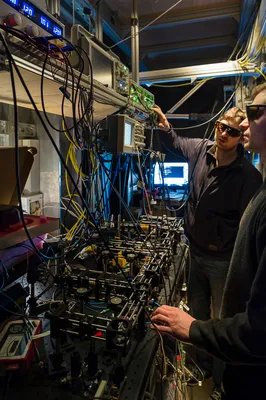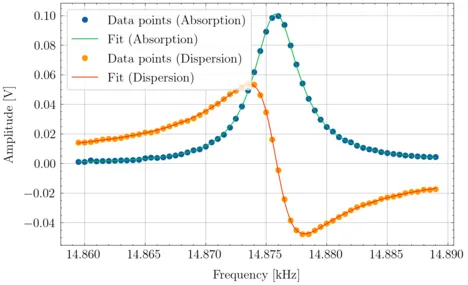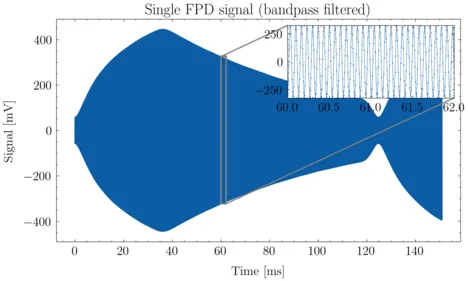Cesium Magnetometry
A new generation neutron EDM experiment will be setup at the Institute Laue-Langevin in Grenoble, seeking for sources of CP violation while providing a new sensitivity limit on the neutron EDM of 10−28 e·cm. According to the Russian physicist Andrei Sacharov, who postulated three necessary conditions for explaining the asymmetry, one of them requires a certain amount of CP violation. The existence of an neutron EDM would fulfillthis criteria. The sensitivity improvement by a factor 100, with respect to the previous generation nEDM limit by the Sussex collaboration, requires a comprehensive understanding of systematics and influences due to magnetic fields on the measurementprinciple (Ramsey’s method of separated oscillatory fields). An all-optical magnetometerarray with up to 32 Cesium based full optical magnetometer heads will be part of the nEDM experiment, avoiding electrical crosstalk or magnetic contaminants (metal parts e.g. wires)and providing uncertainties in the magnetic field detection of ∼ 40 fT/√Hz as measured during an initial characterization attempt at PTB Berlin. Field fluctuations, E×v-effects aswell as geometric phases are influences on the measurement which might mimic an EDM and thus need to be detected precisely.
Besides many other systematic effects, there are influences on the nEDM measurement by possible drifts and any gradients of the magnetic fields. So it becomes necessary to carefully investigate the magnetic field in the UCN storage chamber. For that purpose, full optical Cs atomic magnetometers will be used in the Munich nEDM experiment. These magnetometers will be placed in an array in the empty online access tube. The most important advantage of using Cs atomic magnetometers is that no electrical cables for the transmission of a signal are necessary and thus no additional sources of magnetic fields are added to the UCN storage chamber since only a polarized laser beam is used to interact with the magnetometer. The entire analysis is done outside the magnetically shielded chamber. Furthermore Cs based magnetometers don’t require a lot of maintenance and they don’t have to be cooled with liquid He down to 4 K such SQUIDs. The sensitivity of Cs magnetometers can even surpass the sensitivity of SQUIDs. Finally no crosstalk related noise is expected if light scattering between the magnetometers is avoided. Since an entire array of Cs magnetometers will be set up, the multipolarity of field perturbations can be resolved.
The most famous isotopes for operating an alkali metal atomic magnetometer are 87Rb and 133Cs. The idea behind is, that both are stable isotopes with an unpaired electron in the 5s1 orbital for Rb and in the 6s1 orbital for Cs which spin state can be affected by the interaction of unpaired electrons with photons. In principle, any alkali atom could be used for magnetometry even non-alkali atoms with a non-zero ground state spin level. The reason why the discussion is focused on alkali atoms is due to the fact that their level structure is easier (less relaxation channels), they usually form a monoatomic vapor at reasonable temperatures and can mostly be addressed by using rather inexpensive laser systems. The Munich experiment, Cs is used as an alkali metal vapor, contained in paraffin/silane coated pyrex cells, in order to measure magnetic fields. Cs will be used as it just possesses one stable isotope, which makes it more affordable as no enriched 87Rb is required and it doesn’t need any heating as it comes with a higher vapor density. This gives rise to focus on the Cs atom only in the following sections, but it’s worth to mention that the basic quantum mechanical concepts are analogous valid for Rb.
Publications
- Rosner, M. et al. A highly drift-stable atomic magnetometer for fundamental physics experiments. Appl. Phys. Lett. 120, 161102 (2022) doi: 10.1063/5.0083854.
Theses topics
Our group is actively developing optical atomic magnetometers, a type of sensors using light-atom interactions to detect magnetic fields.This approach, sitting on the junction of laser-optics, quantum-optics and atom-physics, offer a wide range of possibilities for undergraduate and graduate students, from theoretical approaches to practical experiments.
The current in-house build sensor is one of the most stable and sensitiv sensors of its type, reaching stabilities of 35 fT in the minute range.
Possible student trainee positions and thesis projects are:
- Characterization of a non-magnetic Optical Atomic Magnetometer Array
- Development of a non-magnetic Free Space Cesium Magnetometer
- Development of an Optical Earth Field Cesium Magnetometer
- Characterisation and Improvement of Cesium Vapour Cells
- Design and Characterisation of a Magnetically Shielded Test Chamber for Magnetometers
Contact
M.Sc. Philipp Wunderl
- Tel.: +49 (89) 289 - 53716
- Raum: 5101.EG.293
- philipp.wunderl@tum.de


